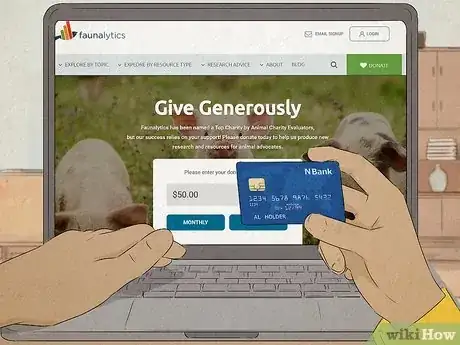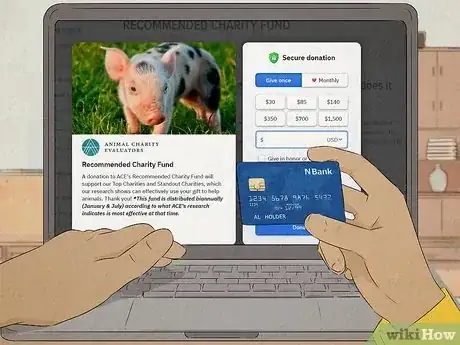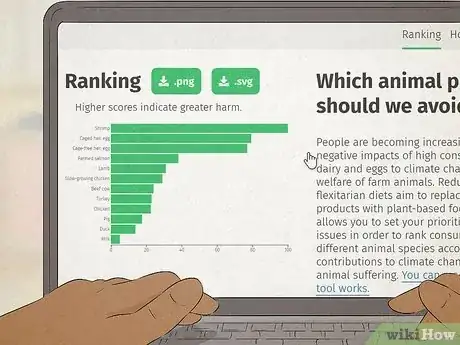wikiHow is a “wiki,” similar to Wikipedia, which means that many of our articles are co-written by multiple authors. To create this article, 9 people, some anonymous, worked to edit and improve it over time.
There are 10 references cited in this article, which can be found at the bottom of the page.
This article has been viewed 1,872 times.
Learn more...
Every year, an estimated 70 billion land animals are slaughtered—ten times the human population—with many of these animals living in inhumane conditions such as caging, overcrowding and even mutilation. Fortunately, there are ways we can all make a difference in the lives of farmed animals; from donating to effective animal charities recommended by Animal Charity Evaluators to volunteering and reducing our consumption of animal products such as fish, chicken and eggs.
Steps
Understanding the Problem
-
1Read the key facts on factory farming. Factory farms account for over 99% of domesticated animals, yet farmed animals are often neglected and receive very little attention. In fact, only 1% of animal funding goes towards farmed animals, while 65% of US animal donations went to animal shelters in 2015 - even though shelters only house less than 1% of the total number of animals.
- Chickens are, by a wide margin, the most slaughtered of all land animals—in fact, an annual 60 billion are killed for their meat. When confined in overcrowded conditions, these creatures may use their beaks to attack each other, resulting in injury and even death. To curb such behavior, many companies resort to cutting off portions of the chickens' beaks—a cruel practice that causes them unending agony.
- Mammals, birds, and even fish—with an estimated 1 trillion killed each year—can all suffer. It stands to reason that the same could be true for insects, too; after all, we slaughter trillions of them annually. Until evidence suggests otherwise, it is reasonable to assume that these creatures are sentient beings.
-
2Imagine the life of an animal inside an intensive farm. You can watch the Food, Inc. documentary or the 10-minute What Cody Saw Will Change Your Life clip to gain an understanding of how animals are treated in an intensive farm.
- You can visit a factory farm or animal sanctuary to see firsthand how these animals are treated. In a farm animal sanctuary, you will meet animals who have been rescued from abuse. Instead, factory farms are often cramped and dirty, so seeing them firsthand can be shocking.
Donating to Effective Charities
-
1Consult Animal Charity Evaluators. Animal Charity Evaluators reviews and recommends animal charities based on their effectiveness. Here are their four recommended charities for 2023:
- Faunalytics connects animal advocates with information. This mostly involves cоnducting and publishing independent research, and promoting existing research and data for individual advocates through their website’s content library.
- The Humane League improves animal welfare standards through grassroots campaigns, movement building, vegan advocacy, research, and advocacy training. The Humane League founded the Open Wing Alliance, an international animal advocacy coalition, to end the use of battery cages globally.
- The Good Food Institute works to promote plant-based and cell-based meat, eggs, and dairy as a way to improve animal welfare and reduce the negative environmental impacts of industrial animal agriculture. They do this through various strategies such as research and development, technical assistance for startups and entrepreneurs, and policy advocacy.
- Wild Animal Initiative works to strengthen the animal advocacy movement by creating an academic field dedicated to wild animal welfare. They compile literature reviews, write theoretical and opinion articles, and publish research results on their websites and peer-reviewed journals.
-
2Read the charity reviews by Animal Charity Evaluators. They publish their research behind their recommendations for free. Read their reviews of the charities that seem most promising. When reading the report, look at the following:
- What does the charity do?
- What’s the cost-effectiveness?
- How transparent is the charity on its impact?
- Are there high-quality studies on the charity’s impact?
- How much more funding can the charity effectively use?
- Does the charity have strong and honest leadership?
-
3Choose your favorite animal charity. Some people may prefer to help a specific species, such as chickens or fish. Others may select a charity that supports the animal welfare advocacy movement. Ultimately, the best animal charity is the one that best aligns with your values and preferences.
-
4Consider donating to Animal Charity Evaluator’s Recommended Charity Fund. The Recommended Charity Fund supports the top-rated animal charities recommended by Animal Charity Evaluators, and you can read their transparent reasoning in their reports of grant distributions.
- By finding the most cost-effective donations, the Fund allows time-constrained donors to save time and be confident that their contributions are making a difference.
-
5Select the donation amount. Be realistic about the amount of money you have to donate. You don't want to set yourself up for disappointment by pledging more money than you can afford.
- Decide whether you want to make a single or recurring donation. By donating every month, you are more likely to continue contributing again in the future. Also, regular donations allow organisations to plan their finances more effectively.
Volunteering
-
1Volunteer with animal welfare organisations. Volunteering for an animal charity is a great way to make a difference. You will also meet like-minded people and learn more about farmed animals.
- Volunteer for the Humane League and join their Fast Action Network. By taking daily actions such as signing petitions, posting on social media, or emailing decision-makers, you can improve the lives of millions of animals.
-
2Find a job helping farmed animals. Working full-time at an effective animal charity can be rewarding and have a huge impact. Check out the Job Board by 80,000 Hours to find the most promising and high impact jobs for animal welfare.
- Also check out the Job Board by Animal Advocacy Careers, which specialises in animal advocacy nonprofits.
-
3Encourage restaurants and offices to provide animal-free options. By increasing the supply of plant-based meals, you help reduce animal cruelty. You can achieve this by:
- Offering more plant-based options.
- Training chefs to provide tasty plant-based meals.
- Having one day of the week vegetarian (e.g., Meatless Mondays).
Eating Ethically
-
1Learn about the benefits of plant-based eating. A plant-based diet helps you live longer, spare lives and reduce pollution. It's not only good for you and good for animals, it's also good for the planet. Switching to a plant-based diet spares ∼100 lives (mostly chicken and fish) every year.
- Plant-based diets are typically lower in saturated fat and cholesterol, and higher in fiber and antioxidants, so they help you reduce cardiovascular disease, diabetes, hypertension, some cancers and Alzheimer's risk.
- As cows eat at least 6 calories for each calorie of beef, feeding animals requires planting vast areas of land (e.g., in the Amazon rainforest) with corn and soy. 75% of global agricultural land is used for livestock, including grazing and land to grow animal feed.
-
2Check out the Food Impacts online tool. Food Impacts ranks species according to contributions to farmed animal suffering and climate change. The image above compares the animal suffering only (excluding climate change), and higher scores indicate greater harm per calorie.
-
3Reduce your fish, chicken and egg consumption. You don't need to become vegan or vegetarian. Eating smaller animals causes greater harm per meal, so cut fish, chicken and eggs to vastly reduce the animal suffering in your diet.
- A cow can produce more than 1,000 burgers, but a chicken yields only a few meals. The average American consumes 25 chickens in a year but only a fraction of a cow.
- If you switch from eating beef to eggs, you would end up causing an even greater amount of suffering. You indirectly kill one chicken every ∼300 eggs you eat.
-
4Develop commercial alternatives, such as clean meat. By providing a similar experience to eating traditional meat, hundreds of startups are working to remove animals—and suffering—from the equation of making meat.
- Follow The Good Food Institute's free online course on The Science behind Alternative Proteins.
Multiplying Your Impact
-
1Share your donation with a friend. By encouraging others to donate to effective charities, you multiply the impact of your gift. For example, you can talk to a friend at dinner or share your donation on social media.
-
2Take the Giving What We Can Pledge. The pledge helps you donate a meaningful portion of your income to improve the lives of others. It can help you live up to your values, meet like-minded people, and inspire others to follow suit. Sign the pledge here.
- Almost 10,000 people signed the Giving What We Can Pledge, a non-binding pledge to donate more than 10% of your income to effective charities.
-
3Stay motivated. Sometimes it's easy to forget why we made a certain decision. Every time you help a farmed animal, such as by avoiding meat and fish, keep in mind that your decision just made the world a slightly better place.
References
- https://animalcharityevaluators.org/donation-advice/recommended-charities/
- https://animalcharityevaluators.org/research/methodology/causes-we-consider/
- https://thehumaneleague.org/article/what-is-factory-farming
- https://www.effectivealtruism.org/articles/cause-profile-animal-welfare
- https://faunalytics.org/global-animal-slaughter-statistics-and-charts/#:~:text=Worldwide%2C%20more%20than%2070%20billion,trends%20by%20type%20of%20animal.
- http://www.fao.org/ag/againfo/resources/en/publications/tackling_climate_change/index.htm
- https://www.givingwhatwecan.org/cause-areas/animal-welfare/farmed-animals/
- https://www.givingwhatwecan.org/cause-areas/animal-welfare/reducing-consumption/
- https://rethinkpriorities.org/publications/insects-raised-for-food-and-feed











































































